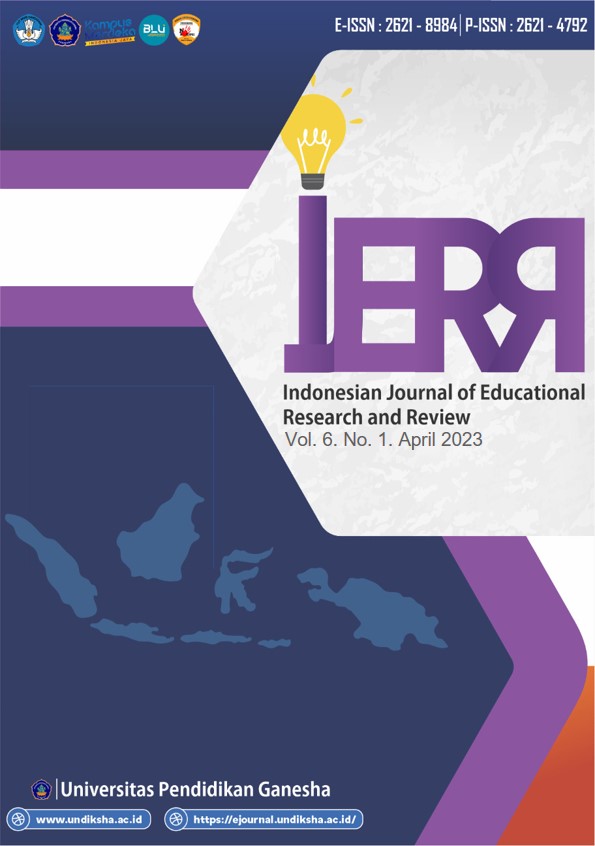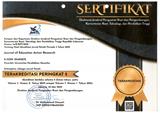The Difficulties of Effective English Speaking in Higher Secondary Level: An Empirical Study on City Area Colleges in Dhaka
DOI:
https://doi.org/10.23887/ijerr.v6i1.54198Kata Kunci:
Competency, Dhaka, effective English speaking, higher secondary level, hindranceAbstrak
English has been inescapably used in everyday life in this period of intense global competition. But for various reasons, students in higher secondary level often struggle to develop adequate speaking skills. And these obstacles affect in their upcoming higher study, going abroad as well as in their future career. The study aims to analysing the prevailing barriers that the learners of higher secondary level encounter in speaking English effectively in their classrooms. This is a quantitative study and descriptive in nature. The respondents of this research were the higher secondary level learners selected by random sampling approach. Total 100 respondents were taken, 25 students from each school from three groups Science, Arts and Business Studies participated. The survey was conducted directly going to the respondents and the duration of the survey was one week. This study pinpoints all of these problems and presents possible recommendations for developing English competence. Future scholars will benefit from the insights of this study as they investigate the difficulties faced by English learners in Bangladesh.
Referensi
Agholor, D., de Nalda, Á. L., & Bárcena, N. S. (2017). Mentoring future engineers in higher education: A descriptive study using a developed conceptual framework. Production, 27(Specialissue), 1–13. https://doi.org/10.1590/0103-6513.220716.
Amin, M. (2019). Developing reading skills through effective readin approaches. International Journal of Social Science and Humanities, 4(1), 35–40. https://doi.org/10.2139/ssrn.3342538.
Amin, M. A., & Greenwood, J. (2018). The examination system in Bangladesh and its impact: on curriculum, students, teachers and society. Language Testing in Asia.
Amin, R. (2022). Primary English teachers’ understanding and practice of existing curriculum of English education in Bangladesh: An exploratory study. Journal of the Association-Institute for English Language and American Studies, 10(10), 57–63. http://www.anglisticum.org.mk/index.php/IJLLIS/article/view/2336.
Arroba, J., & Acosta, H. (2021). Authentic digital storytelling as alternative teaching strategy to develop speaking skills in efl classes. LEARN Journal: Language Education and Acquisition Research Network, 14(1), 317–343. https://doi.org/https://so04.tci-thaijo.org/index.php/LEARN/index.
Büyükkarci, K. (2014). Assessment Beliefs and Practices of Language Teachers in Primary Education. International Journal of Instruction, 7(1), 107–120. https://dergipark.org.tr/en/pub/eiji/issue/5136/69989.
Charalambous, A. C. (2011). The Role and Use of Course Books in EFL. Online Submission, May.
Darmuki, A., Nurkamto, J., & Saddhono, K. (2017). Evaluating Information-processing-based Learning Cooperative Model on Speaking Skill Course. Journal of Language Teaching & Research, 8(1). https://doi.org/10.17507/jltr.0801.06.
Domogen, J. C. (2021). Communication Patterns in English Classes in Public Secondary Schools in Benguet, Philippines. OKARA: Jurnal Bahasa Dan Sastra, 15(1), 22–39. https://doi.org/10.19105/ojbs.v15i1.4166.
Durbahn, M., Rodgers, M., & Peters, E. (2020). The relationship between vocabulary and viewing comprehension. System, 88, 102166. https://doi.org/https://doi.org/10.1016/j.system.2019.102166.
Gizatulina, D., Ismaeva, F., Solnyshkina, M., Martynova, E., & Yarmakeev, I. (2020). Fluctuations of text complexity: the case of Basic State Examination in English. SHS Web of Conferences, 88, 02001. https://doi.org/10.1051/shsconf/20208802001.
Gunantar, D. A. (2017). Textbooks analysis: Analyzing English as a Foreign Language (EFL) textbooks from the perspective of Indonesian culture. Journal of Language and Literature, 11(2), 173–182. https://repository.usm.ac.id/files/journalnas/z171/20180920070237-analisis-buku-teks-:-menganalisis-bahasa-inggris-sebagai-buku-teks-bahasa-asing-dari-perspektif-budaya-indonesia.pdf.
Ha, H. T. (2021). Exploring the relationships between various dimensions of receptive vocabulary knowledge and L2 listening and reading comprehension. Language Testing in Asia, 11(1). https://doi.org/10.1186/s40468-021-00131-8.
Hanifa, R. (2018). EFL published materials: An Evaluation of English textbooks for junior high school in Indonesia. Advances in Language and Literary Studies, 9(2), 166–174. https://doi.org/10.7575/aiac.alls.v.9n.2p.166.
Hawlader, R. A. (2020). Code-switching in the university level students of Bangladesh: An empirical study. Journal of the Association-Institute for English Language and American Studies, 9(3), 41–54. https://papers.ssrn.com/sol3/papers.cfm?abstract_id=3574658.
Howarth, C. (2016). Representations, identity, and resistance in communication. In The Social Psychology of Communication. https://doi.org/10.1057/9780230297616_8.
Hsu, W. (2014). Measuring the vocabulary load of engineering textbooks for EFL undergraduates. English for Specific Purposes, 33(1), 54–65. https://doi.org/10.1016/j.esp.2013.07.001.
Hu, T.-C., Sung, Y.-T., Liang, H.-H., Chang, T.-J., & Chou, Y.-T. (2022). Relative Roles of Grammar Knowledge and Vocabulary in the Reading Comprehension of EFL Elementary-School Learners: Direct, Mediating, and Form/Meaning-Distinct Effects. Frontiers in Psychology, 13, 827007. https://doi.org/10.3389/fpsyg.2022.827007.
Huda, N. L. A., & Ma’mun, N. (2020). The Anxiety of EFL Students in Presentation. Elitejournal.Org, 2(1), 65–84. http://elitejournal.org/index.php/ELITE/article/view/31.
Janebi Enayat, M., & Derakhshan, A. (2021). Vocabulary size and depth as predictors of second language speaking ability. System, 99, 102521. https://doi.org/10.1016/j.system.2021.102521.
Kallinikou, E., & Nicolaidou, I. (2019). Digital Storytelling to Enhance Adults’ Speaking Skills in Learning Foreign Languages: A Case Study. Multimodal Technologies and Interaction, 3(3), 59. https://doi.org/10.3390/mti3030059.
Khromchenko, O., & Shutilo, I. (2021). Approaches and Methods in Language Teaching. Cambridge university press. https://doi.org/10.36074/logos-28.05.2021.v2.05.
Kiany, G. R. (1997). English proficiency and academic achievement in relation to extraversion: A preliminary study. International Journal of Applied Linguistics, 8(1), 113. https://doi.org/10.1111/j.1473-4192.1998.tb00123.x.
Latif, A. (2017). Developing Curriculum of Bachelor in ELT Program Based on the Indonesian National Qualification Framework (KKNI). Premise: Journal of English Education and Applied Linguistics, 6(1), 85–101. https://www.ojs.fkip.ummetro.ac.id/index.php/english/article/view/857/0.
Lee, B. C., Pandian, A., Rethinasamy, S., & Tan, D. A. L. (2019). Effects of PWIM in the ESL classroom: Vocabulary knowledge development among primary Malaysian learners. 3L: Language, Linguistics, Literature, 25(4), 179–197. https://doi.org/10.17576/3L-2019-2504-11.
Lin, V., Yeh, H.-C., Huang, H.-H., & Chen, N.-S. (2022). Enhancing EFL vocabulary learning with multimodal cues supported by an educational robot and an IoT-Based 3D book. System, 104, 102691. https://doi.org/https://doi.org/10.1016/j.system.2021.102691.
Liu, M., & Jackson, J. (2008). An exploration of Chinese EFL learners’ unwillingness to communicate foreign language anxiety. International Journal of Social Science and Humanities Research, 92, 71–86. https://doi.org/10.1111/j.1540-4781.2008.00687.x.
M., R. A. (2018). Learning English Language in Home Environment: A Study. Angloamericanae Journal, 3(1), 39–50. https://papers.ssrn.com/sol3/papers.cfm?abstract_id=3342532.
Maamuujav, U., Krishnan, J., & Collins, P. (2019). The utility of infographics in L2 writing classes: A practical strategy to scaffold writing development. TESOL Journal, September. https://doi.org/10.1002/tesj.484.
Mokshein, S. E., Ishak, H., & Ahmad, H. (2019). the Use of Rasch Measurement Model in English Testing. Jurnal Cakrawala Pendidikan, 38(1), 16–32. https://doi.org/10.21831/cp.v38i1.22750.
Nahari, S., Latief, M. A., & Astuti, U. P. (2020). Factors Contributing to Low Teachers Competencies Score. Jurnal Pendidikan: Teori, Penelitian, Dan Pengembangan, 5(8), 1115. https://doi.org/10.17977/jptpp.v5i8.13906.
Nguyen, S. Van, & Habók, A. (2021). Designing and validating the learner autonomy perception questionnaire. Heliyon, 7(4). https://doi.org/10.1016/j.heliyon.2021.e06831.
Orfan, S. N., Noori, A. Q., & Akramy, S. A. (2021). Afghan EFL instructors’ perceptions of English textbooks. Heliyon, 7(11), e08340. https://doi.org/10.1016/j.heliyon.2021.e08340.
Pratiwi, K. D. (2016). Students ’ difficulties in writing English : A study at the third semester students of English education program At University of Bengkulu. E Journal Universitas Bengkulu, 1(2), 1–13. https://doi.org/10.29300/ling.v3i1.106.
Puspitasari, D., Widodo, H. P., Widyaningrum, L., Allamnakhrah, A., & Lestariyana, R. P. D. (2021). How do primary school English textbooks teach moral values? A critical discourse analysis. Studies in Educational Evaluation, 70, 101044. https://doi.org/10.1016/j.stueduc.2021.101044.
Ramsin, A., & Mayall, H. J. (2019). Assessing ESL learners’ online learning self-efficacy in Thailand: Are they ready? Journal of Information Technology Education: Research, 18, 467–479. https://doi.org/10.28945/4452.
Singh, C. K. S., Ong, E. T., Singh, T. S. M., Maniam, M., & Mohtar, T. M. T. (2021). Exploring esl learners’ reading test taking strategies. Studies in English Language and Education, 8(1), 227–242. https://doi.org/10.24815/siele.v8i1.18130.
Skwarchuk, S. L., Sowinski, C., & LeFevre, J. A. (2014). Formal and informal home learning activities in relation to children’s early numeracy and literacy skills: The development of a home numeracy model. Journal of Experimental Child Psychology, 121(1), 63–84. https://doi.org/10.1016/j.jecp.2013.11.006.
Somdee, M., & Suppasetseree, S. (2013). Developing English speaking skills of thai undergraduate students by digital storytelling through websites. The Foreign Language Learning and Teaching International Conference, 166–176. http://sutir.sut.ac.th:8080/jspui/handle/123456789/4169.
Sultana, N. (2019). Language assessment literacy: an uncharted area for the English language teachers in Bangladesh. Language Testing in Asia, 9(1), 10.1186/s40468-019-0077–0078. https://doi.org/10.1186/s40468-019-0077-8.
Swan, M. (2005). Legislation by hypothesis: The case of task-based instruction. Applied Linguistics, 26(3), 376–401. https://doi.org/10.1093/applin/ami013.
Tresnawati, F., & Musthafa, B. (2016). Expressive Writing in Minimizing Students’ Public Speaking Anxiety. 1991. https://doi.org/10.2991/icse-15.2016.85.
Usman, B., Muslim, A., Champion, I. C. R., & Samad, I. A. (2018). Progressive peer evaluation: Important but absent in EFL speaking classes. Studies in English Language and Education, 5(2), 308–327. https://doi.org/10.24815/siele.v5i2.11115.
Yundayani, A., Susilawati, & Chairunnisa. (2019). Investigating the effect of Canva on students’ writing skills. Journal of English Education, 7(2), 169–176. https://doi.org/10.25134/erjee.v7i2.1800.
Zahra, I. A. (2019). The Effect of Debate Activity in English Four Skills: The Students’ Perspective. In UHAMKA International Conference on ELT and CALL, 57–67. http://download.garuda.kemdikbud.go.id/article.php?article=1482949&val=11431&title=The Effect of Debate Activity in English Four Skills The Students%27 Perspective.
Zahra, R., & Arianti, T. (2022). Implicature analysis on English textbooks for junior high school: A comparison between national and international English textbooks. Journal of Advanced Multidisciplinary Research, 3(1), 1. https://doi.org/10.30659/jamr.3.1.1-18.
Unduhan
Diterbitkan
Cara Mengutip
Terbitan
Bagian
Lisensi
Hak Cipta (c) 2023 Md. Ruhul Amin

Artikel ini berlisensiCreative Commons Attribution-ShareAlike 4.0 International License.
Authors who publish with the Indonesian Journal of Educational Research and Review (IJERR) agree to the following terms:
- Authors retain copyright and grant the journal the right of first publication with the work simultaneously licensed under a Creative Commons Attribution License (CC BY-SA 4.0) that allows others to share the work with an acknowledgment of the work's authorship and initial publication in this journal.
- Authors are able to enter into separate, additional contractual arrangements for the non-exclusive distribution of the journal's published version of the work (e.g., post it to an institutional repository or publish it in a book), with an acknowledgment of its initial publication in this journal.
- Authors are permitted and encouraged to post their work online (e.g., in institutional repositories or on their website) prior to and during the submission process, as it can lead to productive exchanges, as well as earlier and greater citation of published work. (See The Effect of Open Access)












